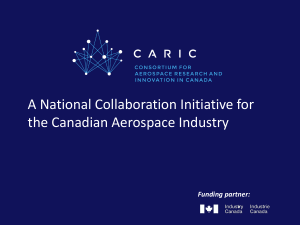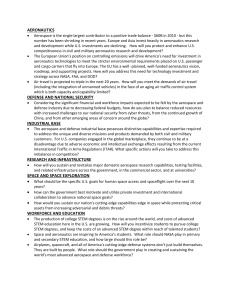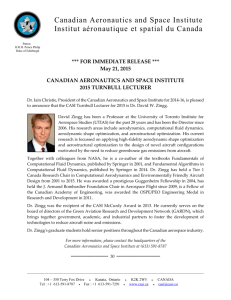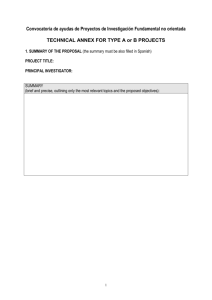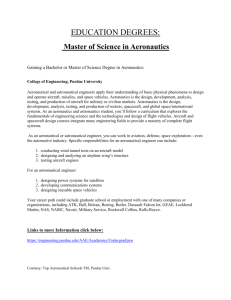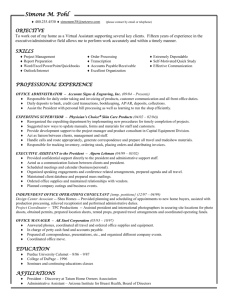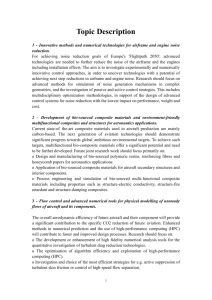Webinar - Public Policy Forum
advertisement
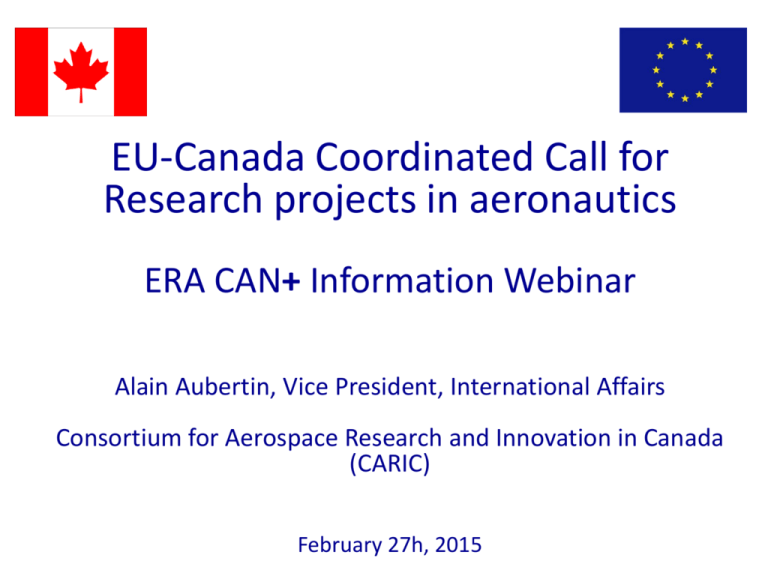
EU-Canada Coordinated Call for Research projects in aeronautics ERA CAN+ Information Webinar Alain Aubertin, Vice President, International Affairs Consortium for Aerospace Research and Innovation in Canada (CARIC) February 27h, 2015 Agenda 1. Introduction 2. CARIC Overview 3. Presentations on Coordinated Call Rules and Guidelines Framework o Canada 4. Projects ideas 5. Next steps EU-Canada coordinated call for research projects in aeronautics WHERE ARE WE NOW ? Launch of CANNAPE action EU-Canada CARIC call publication Proposals evaluation results Call Topics identification Strategic Cross Mapping 2011 2012 PHASE 1 Call implementation Projects set-up 2013 2014 2015 PHASE 2 CANNAPE 5th workshop Pre Coordinated Call Project course 2016 Projects agreement signature & start Proposals submission to H2020 COORDINATION & SUPPORT ACTION ENTITIES FOCUS OUTCOME Strategy CANNAPE CORE GROUP 2nd call Preparation Monitoring CARIC CANNAPE & 1st COORDINATED CALL EC Management 1st Call Projects CANNAPE NETWORK Partnering EU-Canada coordinated call for research projects in aeronautics A National Collaboration Initiative for the Canadian Aerospace Industry Funding partner: About CARIC “Collaborative approaches to R&D yield better results for both participants and the economy. This is particularly true for an industry like aerospace, in which R&D is a costly, long-term undertaking.” – Emerson Report Officially launched in April 2014 $30M financial support from Industry Canada Honourable James Moore, announcing his endorsement of the creation of a new national aerospace research and technology network. 6 CARIC’s Mission 1. To facilitate communications and collaboration among aerospace companies, researchers and academics… …and provide financial support to collaborative R&TD projects. 7 CARIC’s Mission 2. To launch initiatives whose primary purpose is to: – serve as catalysts for collaboration that can help to overcome the silo effects; – promote faster, more relevant R&D. 8 Our Vision Our core business: R&D projects that lead to innovative solutions – Industry focused A key facilitator for the Canadian aerospace research and technology development 9 Outcomes - Metrics 1) CARIC accelerates aerospace research Research projects launched (TRL 1-6) Involvement: academia, research centres and industry Funding provided and leveraging factor Technologies developed 2) CARIC supports student training Students trained Involvement of colleges Outcomes - Metrics (cont’d) 3) CARIC facilitates aerospace network outreach Research Forum & Workshops on cutting edge research fields Web Community Portal usage 4) CARIC supports the innovation system Inventory of research infrastructures Technological road-mapping Mobilizing SMEs Coordinated Call for Research Projects in Aeronautics - 2015 Appel en coordination UE-Canada pour des projets de recherche en aéronautique – 2015 Rules and Guidelines Règles et Principes directeurs EU-Canada coordinated call for research projects in aeronautics Rules and Guidelines Plan www.caric.ca 1. 2. 3. Research topics Opening period Eligibility a. b. c. d. 4. 5. Forms & documents Evaluation a. b. c. 6. Criteria Process Decision Funding a. b. c. 7. Registration Eligible projects Duration & value Expenses Bodies & levels Documents Reporting Proposal preparation guidelines EU-Canada coordinated call for research projects in aeronautics Do not loose sight of the challenge Challenge to tackle Research topics Way to take up the challenge Application - Reducing environmental Design of Novel aircraft impact configurations Aircraft - (emissions, footprint) - New material/application technology coupled with Reducing noise deep understanding of absorption of acoustic Resource-efficient highperformance products and production Reducing energy consumption Examples and guide(s) for project orientation energy High-performance material development & manufacturing, sustainable production Development of more electrical aircraft and Engine and/or Airframe - Manufacturing Material - Electrical systems - Novel configurations vs. tube-wing Multidisciplinary optimization tools complemented with analytical and numerical research Experiments on specific advanced technologies Study of the complex phenomena associated to the absorption of acoustic energy proof-of-concept Experiments to validate the understanding of noise reduction mechanisms. Reduce development and production wastes Green material Manufacturing automation Development of electrical systems and integration Health monitoring system integration EU-Canada coordinated call for research projects in aeronautics Coordinated projects features Eligibility Criteria Topic oriented Activities Canada-European Union Coordinated Call Projects aligned with one or more of the research topics Applied research, proof of concept, development and integration, testing and validation on a small-scale prototype in a laboratory or simulated environment. Canada: minimum 2 industrial + 2 academic partners Partnership EU: minimum 3 independent organizations from 3 different EU member states Min. 7 partners Joint research proposal among Canadian and European partners Research activities coordination Intellectual Property Partners sign an International Project Coordination Agreement This call is a competition : fulfilling eligibility requirements does not guarantee funding 15 EU-Canada coordinated call for research projects in aeronautics Guidelines Canadian portion Partnership • • • • Funding (Separate budgets for the Canadian and the European sides ) • • • • At least 2 industries and 2 academic organizations Industry-led projects Research proposal preparation and submission by academic lead Universities, colleges and industry delivered Industry contribution of 25% (12.5% IK – 12.5% $) of eligible project expenditures NSERC contribution of 25% of eligible project expenditures CARIC contribution of 50% of eligible project expenditures Funding recipients: academics and industries Public funding Funding destination * See scenario following slide 16 up to 75%* of the eligible expenditures Academics and industries Funding Ratio Canadian portion Example for a Project Value: $2 M (« classic » scenario) NSERC $500k CARIC $1M Industry $500k 17 Funding Scenarios Canadian portion Scenario 1 « classic » Expenses Funding Industry $250k Academics $1M NSERC $500k (2x industry) CARIC $250k (max 50% total Project budget) CARIC $750k Industries $1M • • $375k salaries $625k other expenses Total project 2M $ IN-KIND INDUSTRY $250k Funding Scenarios Canadian portion Scenario 2 Expenses Funding Industry $100k Academics $1M NSERC $200K CARIC $700K (max 50% total Project budget) CARIC $300K Industries $1M • • $450k salaries $550k other expenses Total project $2M 19 IN-KIND INDUSTRY $700k Funding Scenarios Canadian portion Scenario 3 Expenses Funding Industry 250K Academics $1.5M NSERC 500K CARIC 750K (= max industries cash + expenditures ) 0 Industries $500K • • $125k (salaries) $375 (other expenses) Total project $2M 20 IN-KIND INDUSTRY 500K Funding Scenarios Canadian portion Scenario 4 Expenses Funding M Industry $400k Academics $1.5M NSERC $800k CARIC $300k Industries $500k • • $125k (salaries) $375k (other expenses) Project $2 M 21 (max 75 % public funding) CARIC $400k IN-KIND INDUSTRY $100k Proposal documents Canadian portion CARIC CRSNG Specific documents for this call: - Application form - Budget breakdown template - International budget template (exemple) - International Project Coordination Agreement - Disclosure endorsement form (CRSNG intended) Collaborative Research and Development Grants forms - Form 101 - Form 100 - Form 183A 22 Innovation Potential Excellence Project objectives Market driven Project Team Clarity Expertise Work plan Complementarity Coherence Evaluation Framework Impact Competitiveness Budget Implementation IP sharing plan Communication Management & dissemination plans Balance Agenda 1. Introduction 2. CARIC Overview 3. Presentations on Coordinated Call Rules and Guidelines Framework o Canada 4. Projects ideas 5. Next steps EU-Canada coordinated call for research projects in aeronautics www.caric.ca 1. Project ideas list (1) NALC - Development and Characterization of Novel Acoustic Liners Concepts – Mr Edith-Roland Fotsing (Ecole polytechnique de Montréal) 2. 3. Green Aircraft Project: Advanced Technologies and Configurations for Reduced Emissions and Noise – Mr David Zingg (UTIAS) Electromagnetic Simulation and modeling tools for composite aircraft – Mr Fidèle Moupfouma (Bombardier Aeronautics) 4. Forming / distorsion correction by (stress) shot peen forming – Mrs Hong-Yan Miao (Ecole Polytechnique de Montréal) 5. Autonomous Electrical Systems for Aircraft and Rotorcraft Safety – Mr Fred Nitzsche (DLR & Carleton University) 6. 7. Active Control Technologies for green aircraft – Mrs Ruxandra Botez (ÉTS) Surface Modification Processes for High-Performance Materials – Mr Mario Guagliano (Politecnico di Milano) 8. Ecological Materials for Aircraft Interiors 9. Novel thermoplastic composites for aircraft structures 10. Additive Manufacturing Optimization and Simulation Platform EU-Canada coordinated call for research projects in aeronautics Mrs Yaoyao, Fiona, Zhao (McGill) Project ideas list (2) 11. Hybrid components by MIM technology – from IK4 Azterlan (Spain) 12. TPE2AQ : Turbojet Pollutant Emission and Airport Air Quality – from ESTACA`Lab (France) 13. PCM: Phononic Composite Materials – from ESTACA (France) 14. Post process development after SLM for aero engıne components – from TUSAS Engine (Turkey) 15. Thermoplastic Aerospace WElded Structures (TAWES) 16. Reliable and Efficient Method for COmposite Design (REMCOD) Fireproof Acoustic New Engine Sandwich COnfiguration (FANESCO) 17. CHOpped fiber thermoplastic COmposite (CHOCO) Visit: http://www.caric.ca EU-Canada coordinated call for research projects in aeronautics from DEMA (Italy) Agenda 1. Webinar Introduction 2. Presentations on Coordinated Call Rules and Guidelines Framework o European Union o Canada 3. Projects ideas 4. Next steps EU-Canada coordinated call for research projects in aeronautics Proposal preparation agenda Team set-up • Expertise sought • Partner search Objectives definition • Partners interests & challenges Research plan preparation • Deliverables • budget Support plan definition • Project agreement • Project management • Dissemination plan Proposal EU-Canada coordinated call for research projects in aeronautics Next steps Participants Now to April: – http://www.caric.ca – Partner connection & search • Final discussions between European & Canadian partners – Project building & submission Less than 2 months CARIC Exploit NCPs and networks to connect people and help industrial & research communities to build projects Involving Canadian companies, organizations and universities Tight coordination with EC and NSERC for evaluation process Timeline for projects set-up and 1st call July/October 2014 Call publication Project preparation November 2014 Ottawa Meeting Q4 2015 Projects signature January 2016 projects start Project evaluation April 2015 Deadline for submission to EC and CARIC (NSERC) Project start Toward a 2nd coordinated call … Contacts Alain Aubertin, Ph.D., Vice-President, International Affairs, CARIC Canada National Contact Point, Aeronautics – Horizon2020 alain.aubertin@criaq.aero http://www.caric.ca Cédric Prince, Program Director, CARIC Cedric.prince@caric.ca Debbie Kempt, DFATD, Gvt of Canada Debbie.Kemp@international.gc.ca Era-Can+ for overall EU-CA R&I support desole@apre.it http://www.era-can.net EU-Canada Coordinated Call for Research projects in aeronautics ERA CAN+ Information Webinar Thank you!
